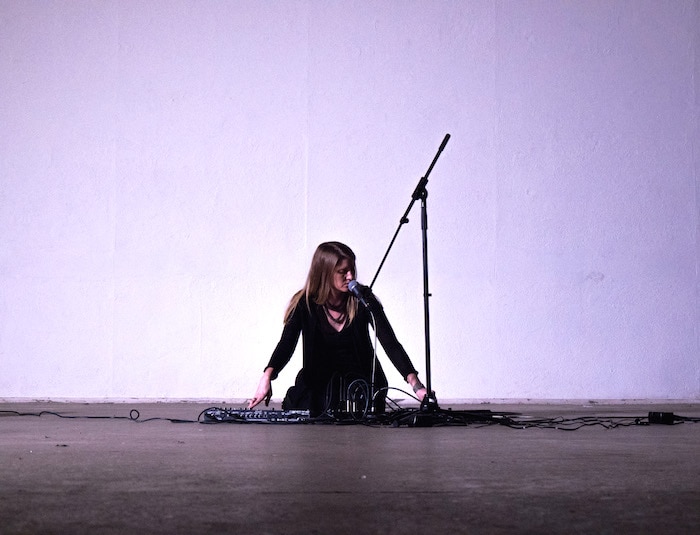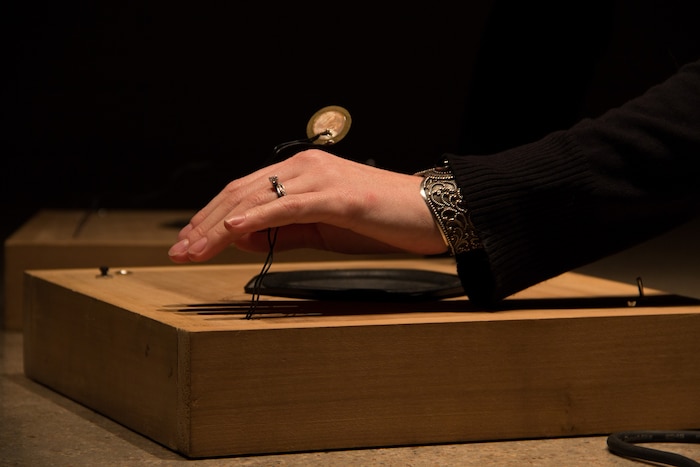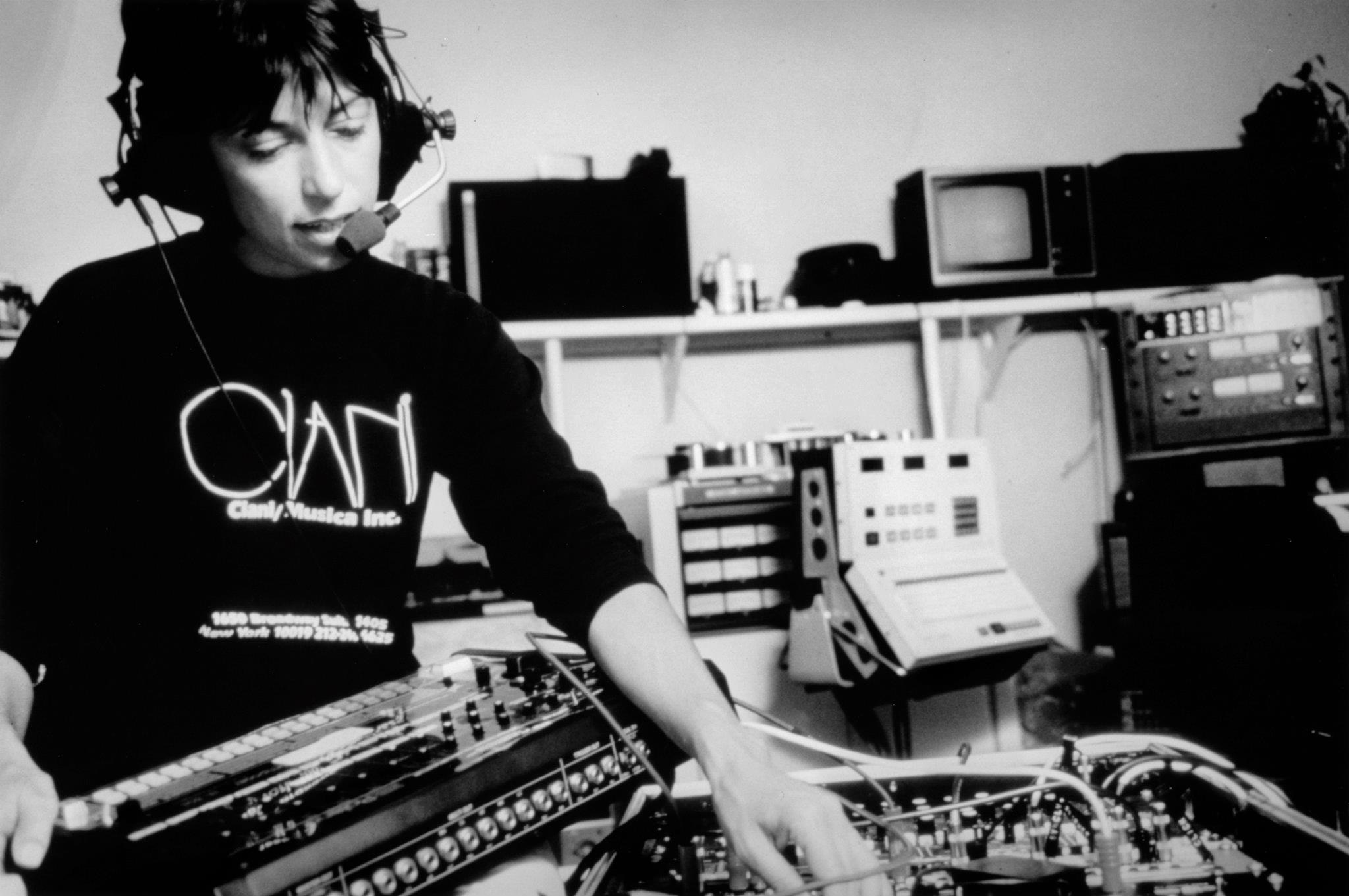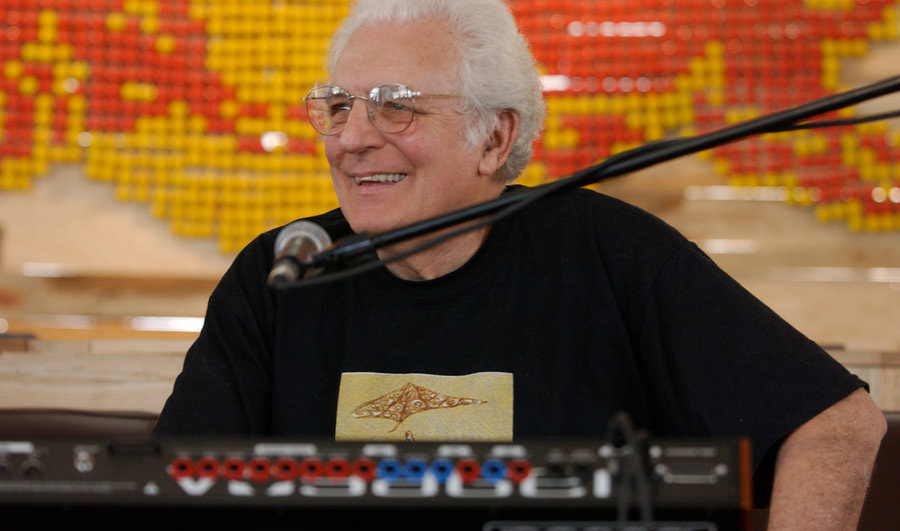Lesley Flanigan’s Vision of Sound
In pursuit of new rhythms with the instrument designer and feedback wrangler

Lesley Flanigan, an experimental electronic musician, is performing her new piece “Hedera” at the venue National Sawdust in Williamsburg. First, there is a repetitive scratching, like an analog camera advancing at 110 beats per minute. Within this beat are hints of other sounds: the simultaneous striking of many drums, slowed down machine gun fire, children’s noisemakers. Flanigan sits on the floor behind MIDI controllers and sings into a mic, turning her loops on and off.
“Hedera” transforms slowly over its 20-minute duration, but its beat never fully lets up, even when Flanigan’s layers of vocals nearly wash it away. This beat is the scaffolding of the piece: a distorted clicking noise which Flanigan held onto for months, adjusting the frequencies and precisely placing the wordless vocals that weave around it. Its pace feels like a panic attack, a racing heartbeat.
This work is the result of a big new presence in Flanigan’s life – her first child. After years of making work centered around speaker feedback created with her homemade instruments, Flanigan says that, after the birth of her daughter, those reliable noises just didn’t sound right. “My ears just didn’t want to listen to those sounds,” she says, sitting in the studio in Williamsburg where she works with her husband. “But I was singing a lot to my daughter. I was thinking a lot about voice.”
Voice, to Flanigan, can mean many things. Growing up in Tampa, Florida, she sang in a church choir before attending art school for sculpture. Though she was untrained, she’d always been interested in creating music, whether with her high school band or the group she started after moving to Denver to escape her hometown. That brief stint in Colorado ended as soon as Flanigan saved enough money to make it to New York City, in 2002.
After spending four years working as a video editor, Flanigan decided she needed to get back to working with her hands. “On some level I always pictured myself on a ladder in my future,” she says. “I never really enjoyed sitting behind a computer.” Still, unsure of what she was interested in, Flanigan applied to the Interactive Telecommunications Program (ITP) at New York University, a two year program that allows students to explore new creative applications for technology. There, she discovered physical computing and spent her time building simple circuits. ITP also gave her access to their wood shop, renewing a love of carpentry from when she was in school for sculpture. When she realized that she could build a simple speaker that amplified a sound circuit, something clicked. Or rather, screeched.
Flanigan still has that first speaker. She brings it over to where we’re sitting and flips the switch. The attached contact mic elicits a small explosion of noises, squeals, drones and thrums. “I heard a sound like that,” she says, “and I was like, ‘Holy shit, that’s beautiful!’”

Flanigan had long been chasing sounds like these. “I can remember trying to create dirty, raw electronic sounds, but they always just sounded clean somehow, not real. When these sounds started coming out of these speakers, they were these fucked-up sounds,” she says, delightedly. “But because they were small speakers and because it was a small power source, it wasn’t like feedback coming out of a PA system. It was actually very controlled.”
“As I got further into it and started building these instruments [they] spoke to me as a voice,” she says. “I loved the fact that each speaker really did have its own sound. It wasn’t replicated or perfect.” These speakers, with their ragged, analog tones, brought out something she liked in her own voice as well. “It became a very natural thing for me to want to sing with them,” she says. “There’s just something about when [the sound] got really dirty and messy and loud and crunchy, and my voice could come in and, not tame it, but introduce people to why those sounds might be beautiful by contrast.”
In 2009, Flanigan self-released her first album, Amplifications, which she considered a way to introduce each of her instruments to the world. It was also a way to fund a tour, booked with her now-husband, the experimental composer and visual artist Tristan Perich. They traveled for two months, and Flanigan says that time helped her cement her artistic vision. She was shocked by the enthusiasm with which people responded to her work. “I had zero expectations for [this work], really, just a true love for wanting to make these sounds operate,” she says.
Flanigan has had few releases since that debut LP. “There is nothing that I’ve done that I haven’t thought a lot about,” she says. When she put out the two track EP Glacier, in 2014, it was only done out of a need to demonstrate the growth of her music. “That’s a problematic feeling, that my recording that’s out there is not really current,” she says.
“Hedera” is a departure from these two releases. It came about by accident, after her discovery of a clicking noise that became the backing beat. “We would go on a drive and I’d play it, and I had these frequencies where I would drop the bass so low that the car shook,” she laughs. After the birth of her daughter, recording with voice alone meant she could keep the noise down around a sensitive newborn. She mapped out a 20-minute track using the beat she’d created, and worked from there. All of Flanigan’s previous recordings were improvisational. But with this track, Flanigan composed the vocals she’d be using over time, then recorded the end result live. “I’m very particular about where the different notes get recorded, so I have them in a specific loop that I can weave in and out,” she says. “It became this sculptural process, just the voice over this beat.”
For the release of “Hedera,” Flanigan decided she would base an entire show around the use of voice, and the openers she chose for the show at National Sawdust reflected this focus in diverse ways. C. Spencer Yeh, who released a record called Solo Voice in 2015, performed that album at the show, sometimes sounding like amplified popcorn popping and other times like someone singing into an industrial fan. Nick Hallett and Daisy Press, two classically trained singers, performed their gorgeous take on the compositions of the 12th century composer St. Hildegard, while Maria Chavez, an avant-turntablist, created an eerie improvised remix using an audio dictionary, interviews and other obscure vinyl recordings.
Flanigan’s debut performance of “Hedera” felt both meditative and anxious. The song’s beat is relentless, and when I closed my eyes its sound seemed to envelop me entirely. Flanigan is pregnant again, which, along with her warm personality, might give her an air of softness, but the lights at National Sawdust accentuated her cheekbones and her beat charged the room with intensity. Her voice was pretty, but she looked fierce.
After getting this recording out of her system, Flanigan says she is ready to take on her speakers again. Her next release will be another speaker feedback album, using techniques that she picked up during a two day durational performance at the Guggenheim. “If it’s a good performance, I give myself the time to not make a change [to the sound] unless it’s the right moment. In the studio it’s too easy to keep fucking around.” she says. “That was one of the great things about that installation [at the Guggenheim]. I let that sound I made exist in the space, and listened in a way that I’d never really gotten to listen before.” For her next album, she will set up a similar installation in her own studio, using the technique she learned at the Guggenheim to capture several days of material that can be edited down into something she hopes will represent her current vision.
Flanigan strives to create music that is not experimental for the sake of experimentation, but as a way to reflect her deep love for the sounds she creates. “I would never want to make music I don’t want to listen to,” she says, and Flanigan’s vision of sound is something she hopes everyone can appreciate. “I always felt a little nervous before shows, that I was going to come across as a weirdo with my speaker feedback. But on some level I never really wanted to be a weirdo,” she says. “This is real music that I’m making,” she adds, with urgency. “Can you hear this?”

